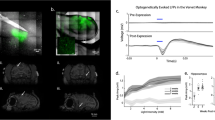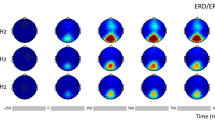Abstract
Electrical stimulation has been used in animals and humans to study potential causal links between neural activity and specific cognitive functions. Recently, it has found increasing use in electrotherapy and neural prostheses. However, the manner in which electrical stimulation–elicited signals propagate in brain tissues remains unclear. We used combined electrostimulation, neurophysiology, microinjection and functional magnetic resonance imaging (fMRI) to study the cortical activity patterns elicited during stimulation of cortical afferents in monkeys. We found that stimulation of a site in the lateral geniculate nucleus (LGN) increased the fMRI signal in the regions of primary visual cortex (V1) that received input from that site, but suppressed it in the retinotopically matched regions of extrastriate cortex. Consistent with previous observations, intracranial recordings indicated that a short excitatory response occurring immediately after a stimulation pulse was followed by a long-lasting inhibition. Following microinjections of GABA antagonists in V1, LGN stimulation induced positive fMRI signals in all of the cortical areas. Taken together, our findings suggest that electrical stimulation disrupts cortico-cortical signal propagation by silencing the output of any neocortical area whose afferents are electrically stimulated.
This is a preview of subscription content, access via your institution
Access options
Subscribe to this journal
Receive 12 print issues and online access
$209.00 per year
only $17.42 per issue
Buy this article
- Purchase on Springer Link
- Instant access to full article PDF
Prices may be subject to local taxes which are calculated during checkout







Similar content being viewed by others
References
Sultan, F., Augath, M. & Logothetis, N. BOLD sensitivity to cortical activation induced by micro stimulation: comparison to visual stimulation. Magn. Reson. Imaging 25, 754–759 (2007).
Tolias, A.S. et al. Mapping cortical activity elicited with electrical microstimulation using fMRI in the macaque. Neuron 48, 901–911 (2005).
Felleman, D.J. & Van Essen, D.C. Distributed hierarchical processing in primate cerebral cortex. Cereb. Cortex 1, 1–47 (1991).
Logothetis, N.K., Pauls, J., Augath, M., Trinath, T. & Oeltermann, A. Neurophysiological investigation of the basis of the fMRI signal. Nature 412, 150–157 (2001).
Goense, J.B. & Logothetis, N.K. Neurophysiology of the BOLD fMRI signal in awake monkeys. Curr. Biol. 18, 631–640 (2008).
Friston, K.J. et al. Analysis of fMRI time-series revisited. Neuroimage 2, 45–53 (1995).
Shipp, S. The functional logic of cortico-pulvinar connections. Phil. Trans. R. Soc. Lond. B 358, 1605–1624 (2003).
Sherman, S.M. The thalamus is more than just a relay. Curr. Opin. Neurobiol. 17, 417–422 (2007).
Shmuel, A., Augath, M., Oeltermann, A. & Logothetis, N.K. Negative functional MRI response correlates with decreases in neuronal activity in monkey visual area V1. Nat. Neurosci. 9, 569–577 (2006).
Sincich, L.C., Park, K.F., Wohlgemuth, M.J. & Horton, J.C. Bypassing V1: a direct geniculate input to area MT. Nat. Neurosci. 7, 1123–1128 (2004).
Butovas, S. & Schwarz, C. Detection psychophysics of intracortical microstimulation in rat primary somatosensory cortex. Eur. J. Neurosci. 25, 2161–2169 (2007).
Douglas, R.J. & Martin, K.A. A functional microcircuit for cat visual cortex. J. Physiol. (Lond.) 440, 735–769 (1991).
Chung, S. & Ferster, D. Strength and orientation tuning of the thalamic input to simple cells revealed by electrically evoked cortical suppression. Neuron 20, 1177–1189 (1998).
Kara, P., Pezaris, J.S., Yurgenson, S. & Reid, R.C. The spatial receptive field of thalamic inputs to single cortical simple cells revealed by the interaction of visual and electrical stimulation. Proc. Natl. Acad. Sci. USA 99, 16261–16266 (2002).
Butovas, S., Hormuzdi, S.G., Monyer, H. & Schwarz, C. Effects of electrically coupled inhibitory networks on local neuronal responses to intracortical microstimulation. J. Neurophysiol. 96, 1227–1236 (2006).
Butovas, S. & Schwarz, C. Spatiotemporal effects of microstimulation in rat neocortex: a parametric study using multielectrode recordings. J. Neurophysiol. 90, 3024–3039 (2003).
Logothetis, N.K., Kayser, C. & Oeltermann, A. In vivo measurement of cortical impedance spectrum in monkeys: implications for signal propagation. Neuron 55, 809–823 (2007).
Brewer, A.A., Press, W.A., Logothetis, N.K. & Wandell, B.A. Visual aeas in macaque cortex measured using functional magnetic resonance imaging. J. Neurosci. 22, 10416–10426 (2002).
Rauch, A., Rainer, G. & Logothetis, N.K. The effect of a serotonin-induced dissociation between spiking and perisynaptic activity on BOLD functional MRI. Proc. Natl. Acad. Sci. USA 105, 6759–6764 (2008).
Pezaris, J.S. & Reid, R.C. Demonstration of artificial visual percepts generated through thalamic microstimulation. Proc. Natl. Acad. Sci. USA 104, 7670–7675 (2007).
Fries, W. & Distel, H. Large layer VI neurons of monkey striate cortex (Meynert cells) project to the superior colliculus. Proc. R Soc. Lond. B Biol. Sci. 219, 53–59 (1983).
Bullier, J. & Henry, G.H. Laminar distribution of 1st-order neurons and afferent terminals in cat striate cortex. J. Neurophysiol. 42, 1271–1281 (1979).
Gradinaru, V., Mogri, M., Thompson, K.R., Henderson, J.M. & Deisseroth, K. Optical deconstruction of Parkinsonian neural circuitry. Science 324, 354–359 (2009).
Li, C.L. Cortical intracellular synaptic potentials in response to thalamic stimulation. J. Cell. Comp. Physiol. 61, 165–179 (1963).
Berman, N.J., Douglas, R.J., Martin, K.A. & Whitteridge, D. Mechanisms of inhibition in cat visual cortex. J. Physiol. (Lond.) 440, 697–722 (1991).
Douglas, R.J., Martin, K.A. & Whitteridge, D. An intracellular analysis of the visual responses of neurones in cat visual cortex. J. Physiol. (Lond.) 440, 659–696 (1991).
Okun, M. & Lampl, I. Instantaneous correlation of excitation and inhibition during ongoing and sensory-evoked activities. Nat. Neurosci. 11, 535–537 (2008).
Douglas, R.J. & Martin, K.A.C. Recurrent neuronal circuits in the neocortex. Curr. Biol. 17, R496–R500 (2007).
Markram, H. et al. Interneurons of the neocortical inhibitory system. Nat. Rev. Neurosci. 5, 793–807 (2004).
Keller, A. Intrinsic synaptic organization of the motor cortex. Cereb. Cortex 3, 430–441 (1993).
DeFelipe, J., Conley, M. & Jones, E.G. Long-range focal collateralization of axons arising from corticocortical cells in monkey sensory-motor cortex. J. Neurosci. 6, 3749–3766 (1986).
Berger, T.K., Perin, R., Silberberg, G. & Markram, H. Frequency-dependent disynaptic inhibition in the pyramidal network: a ubiquitous pathway in the developing rat neocortex. J. Physiol. 587, 5411–5425 (2009).
Tehovnik, E.J., Slocum, W.M., Carvey, C.E. & Schiller, P.H. Phosphene induction and the generation of saccadic eye movements by striate cortex. J. Neurophysiol. 93, 1–19 (2005).
Salzman, C.D., Murasugi, C.M., Britten, K.H. & Newsome, W.T. Microstimulation in visual area MT: effects on direction discrimination performance. J. Neurosci. 12, 2331–2355 (1992).
Murphey, D.K. & Maunsell, J.H.R. Behavioral detection of electrical microstimulation in different cortical visual areas. Curr. Biol. 17, 862–867 (2007).
Lehky, S.R. & Sejnowski, T.J. Network model of shape-from-shading: neural function arises from both receptive and projective fields. Nature 333, 452–454 (1988).
Moeller, S., Freiwald, W.A. & Tsao, D.Y. Patches with links: a unified system for processing faces in the macaque temporal lobe. Science 320, 1355–1359 (2008).
Moore, T., Armstrong, K.M. & Fallah, M. Visuomotor origins of covert spatial attention. Neuron 40, 671–683 (2003).
Moore, T. & Armstrong, K.M. Selective gating of visual signals by microstimulation of frontal cortex. Nature 421, 370–373 (2003).
Armstrong, K.M., Fitzgerald, J.K. & Moore, T. Changes in visual receptive fields with microstimulation of frontal cortex. Neuron 50, 791–798 (2006).
Stanton, G.B., Bruce, C.J. & Goldberg, M.E. Topography of projections to posterior cortical areas from the macaque frontal eye fields. J. Comp. Neurol. 353, 291–305 (1995).
Schall, J.D., Morel, A., King, D.J. & Bullier, J. Topography of visual-cortex connections with frontal eye field in macaque: convergence and segregation of processing sreams. J. Neurosci. 15, 4464–4487 (1995).
Ruff, C.C. et al. Concurrent TMS-fMRI and psychophysics reveal frontal influences on human retinotopic visual cortex. Curr. Biol. 16, 1479–1488 (2006).
Ekstrom, L.B., Roelfsema, P.R., Arsenault, J.T., Bonmassar, G. & Vanduffel, W. Bottom-up dependent gating of frontal signals in early visual cortex. Science 321, 414–417 (2008).
Ekstrom, L.B., Roelfsema, P.R., Arsenault, J.T., Kolster, H. & Vanduffel, W. Modulation of the contrast response function by electrical microstimulation of the macaque frontal eye field. J. Neurosci. 29, 10683–10694 (2009).
Guillery, R.W. Anatomical evidence concerning the role of the thalamus in corticocortical communication: a brief review. J. Anat. 187, 583–592 (1995).
Cowey, A. The Ferrier Lecture 2004. What can transcranial magnetic stimulation tell us about how the brain works? Philos. Trans. R Soc. Lond. B Biol. Sci. 360, 1185–1205 (2005).
Hallett, M. Transcranial magnetic stimulation: a primer. Neuron 55, 187–199 (2007).
Allen, E.A., Pasley, B.N., Duong, T. & Freeman, R.D. Transcranial magnetic stimulation elicits coupled neural and hemodynamic consequences. Science 317, 1918–1921 (2007).
Driver, J., Blankenburg, F., Bestmann, S., Vanduffel, W. & Ruff, C.C. Concurrent brain-stimulation and neuroimaging for studies of cognition. Trends Cogn. Sci. 13, 319–327 (2009).
Acknowledgements
We thank C. Kayser, O. Eschenko and M. Munk for reading the manuscript and for useful suggestions. Many thanks also go to D. Blaurock for editing, S. Weber for fine-mechanic work and T. Steudel and P. Douay for help with the alert monkey experiments. This research was supported by the Max Planck Society, the German Research Foundation (DFG SFB-A9) and by the intramural research program of the US National Institutes of Health (National Institute Neurological Disorders and Stroke, H.M.).
Author information
Authors and Affiliations
Contributions
N.K.L. conceived the project, designed and supervised the experiments under anesthesia, analyzed the data and wrote the paper. M.A. and Y.M. conducted the experiments. A.R. designed and conducted the pharmacology experiments. F.S. helped with flat-map reconstructions. J.G. and Y.M. conducted the alert monkey experiments. A.O. developed and optimized the data acquisition and microstimulation hardware. H.M. developed and optimized the radiofrequency coils.
Corresponding author
Ethics declarations
Competing interests
The authors declare no competing financial interests.
Supplementary information
Supplementary Text and Figures
Supplementary Figures 1–5 (PDF 732 kb)
Rights and permissions
About this article
Cite this article
Logothetis, N., Augath, M., Murayama, Y. et al. The effects of electrical microstimulation on cortical signal propagation. Nat Neurosci 13, 1283–1291 (2010). https://doi.org/10.1038/nn.2631
Received:
Accepted:
Published:
Issue Date:
DOI: https://doi.org/10.1038/nn.2631
This article is cited by
-
State-dependent effects of neural stimulation on brain function and cognition
Nature Reviews Neuroscience (2022)
-
Semi-Implantable Bioelectronics
Nano-Micro Letters (2022)
-
Neurophysiological considerations for visual implants
Brain Structure and Function (2022)
-
A data resource from concurrent intracranial stimulation and functional MRI of the human brain
Scientific Data (2020)
-
Direct stimulation of somatosensory cortex results in slower reaction times compared to peripheral touch in humans
Scientific Reports (2019)



